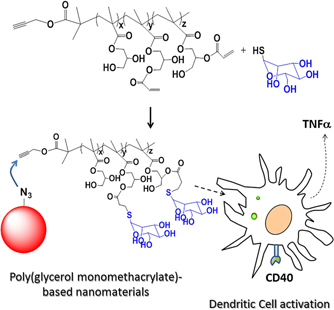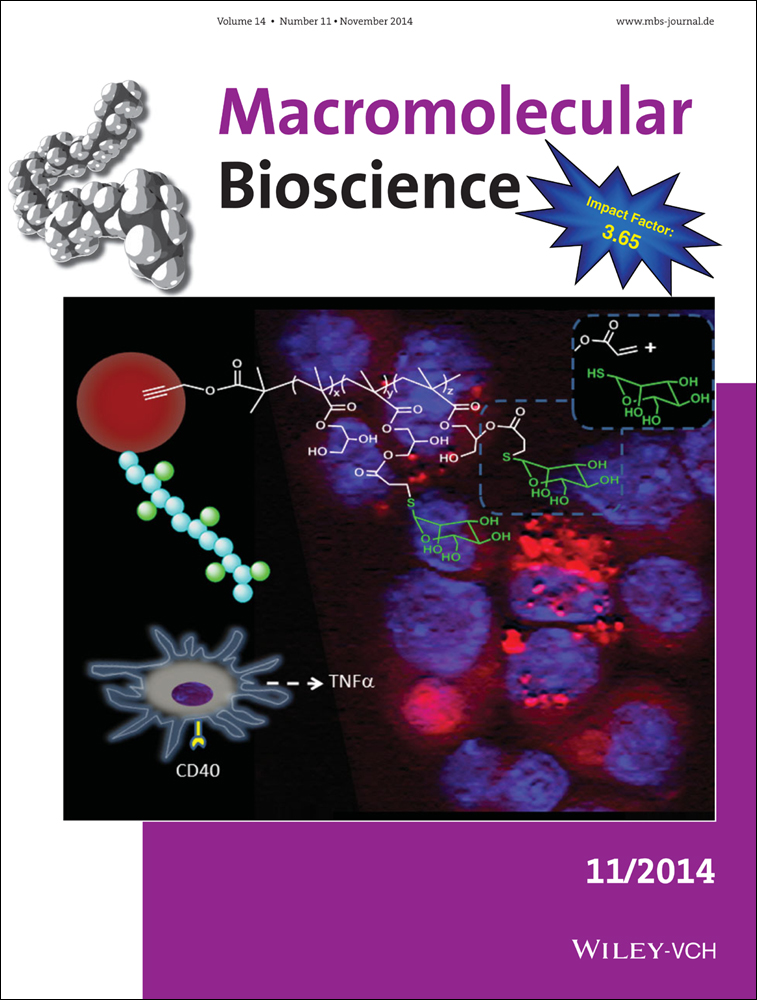An Orthogonal Click-Chemistry Approach to Design Poly(glycerol monomethacrylate)-based Nanomaterials for Controlled Immunostimulation
Lakshminarayanan Ragupathy
School of Pharmacy and Pharmaceutical Sciences, University of Manchester, Oxford Road, Manchester, M13 9PT UK
Present address: Corporate Research and Development Center, HLL Lifecare Limited (A Government of India Enterprise), Akkulam, Sreekaryam, Trivandrum 695017, IndiaSearch for more papers by this authorDouglas G. Millar
Faculty of Life Sciences, University of Manchester, M13 9PT United Kingdom
Present address: Campbell Family Institute for Breast Cancer Research, Princess Margaret Cancer Centre, 620 University Avenue, Toronto, Ontario, Canada M5G 2C1Search for more papers by this authorNicola Tirelli
School of Biomedicine and School of Materials, University of Manchester, Laboratory for Polymers and Biomaterials, Stopford Building, Manchester, M13 9PT UK
Search for more papers by this authorCorresponding Author
Francesco Cellesi
School of Pharmacy and Pharmaceutical Sciences, University of Manchester, Oxford Road, Manchester, M13 9PT UK
Present address: 1. Fondazione CEN - European Centre for Nanomedicine, Piazza Leonardo da Vinci 32, 20133 Milan, Italy; 2. Fondazione IRCCS Ca' Granda Ospedale Maggiore Policlinico, Via Pace 9, I-20122 Milan, Italy; 3. Dipartimento di Chimica, Materiali ed Ingegneria Chimica "G. Natta". Politecnico di Milano, Via Mancinelli 7, 20131 Milan, ItalySearch for more papers by this authorLakshminarayanan Ragupathy
School of Pharmacy and Pharmaceutical Sciences, University of Manchester, Oxford Road, Manchester, M13 9PT UK
Present address: Corporate Research and Development Center, HLL Lifecare Limited (A Government of India Enterprise), Akkulam, Sreekaryam, Trivandrum 695017, IndiaSearch for more papers by this authorDouglas G. Millar
Faculty of Life Sciences, University of Manchester, M13 9PT United Kingdom
Present address: Campbell Family Institute for Breast Cancer Research, Princess Margaret Cancer Centre, 620 University Avenue, Toronto, Ontario, Canada M5G 2C1Search for more papers by this authorNicola Tirelli
School of Biomedicine and School of Materials, University of Manchester, Laboratory for Polymers and Biomaterials, Stopford Building, Manchester, M13 9PT UK
Search for more papers by this authorCorresponding Author
Francesco Cellesi
School of Pharmacy and Pharmaceutical Sciences, University of Manchester, Oxford Road, Manchester, M13 9PT UK
Present address: 1. Fondazione CEN - European Centre for Nanomedicine, Piazza Leonardo da Vinci 32, 20133 Milan, Italy; 2. Fondazione IRCCS Ca' Granda Ospedale Maggiore Policlinico, Via Pace 9, I-20122 Milan, Italy; 3. Dipartimento di Chimica, Materiali ed Ingegneria Chimica "G. Natta". Politecnico di Milano, Via Mancinelli 7, 20131 Milan, ItalySearch for more papers by this authorAbstract
A versatile approach is proposed for the synthesis of novel immunoactive nanomaterials based on biocompatible poly(glycerol monomethacrylate) (PGMMA). Propargyl-terminated PGMMA is synthesized via atom transfer radical polymerization and then modified through the introduction of dangling acrylate groups, at controlled degree of functionalisation. Acrylates are then able to react quantitatively with thiols, such as immunoactive thiomannose, through Michael-type addition under mild conditions and at a physiologically acceptable pH. The terminal propargyl group can be modified independently with azide end-capping groups and it is utilized to graft the macromolecules to a fluorescent dye. The resulting mannose-linked PGMMAs confirm a safe cytotoxic profile and are able to stimulate cytokine production (TNFα), membrane protein expression (CD40), and cellular uptake in bone marrow derived dendritic cells. Cell stimulation is dependent on the mannose content and enhanced by serum proteins, suggesting a role for mannose-binding receptors and/or complement receptors in the cell membrane.
Supporting Information
As a service to our authors and readers, this journal provides supporting information supplied by the authors. Such materials are peer reviewed and may be re-organized for online delivery, but are not copy-edited or typeset. Technical support issues arising from supporting information (other than missing files) should be addressed to the authors.
| Filename | Description |
|---|---|
| mabi201400146-sm-0001-SuppData.docx509.4 KB | Supporting Data. |
Please note: The publisher is not responsible for the content or functionality of any supporting information supplied by the authors. Any queries (other than missing content) should be directed to the corresponding author for the article.
References
- 1 R. Duncan, M. J. Vicent, Adv. Drug Delivery Rev. 2013, 65, 60.
- 2 Y. Zhang, H. F. Chan, K. W. Leong, Adv. Drug Delivery Rev. 2013, 65, 104.
- 3 M. D. Howard, M. Jay, T. D. Dziublal, X. L. Lu, J. Biomed. Nanotechnol. 2008, 4, 133.
- 4 J. A. Hubbell, S. N. Thomas, M. A. Swartz, Nature 2009, 462, 449.
- 5 D. M. Smith, J. K. Simon, J. R. Baker, Jr., Nat. Rev. Immunol. 2013, 13, 592.
- 6 T. D. Nandedkar, J. Biosci. 2009, 34, 995.
- 7 Y. Perrie, A. R. Mohammed, D. J. Kirby, S. E. McNeil, V. W. Bramwell, Int. J. Pharm. 2008, 364, 272.
- 8 S. L. Demento, A. L. Siefert, A. Bandyopadhyay, F. A. Sharp, T. M. Fahmy, Trends Biotechnol. 2011, 29, 294.
- 9 D. J. Irvine, M. A. Swartz, G. L. Szeto, Nat. Mater. 2013, 12, 978.
- 10 N. Petrovsky, J. C. Aguilar, Immunol. Cell Biol. 2004, 82, 488.
- 11 Z. Wu, Y. Du, H. Xue, Y. Wu, B. Zhou, Neurobiol. Aging 2012, 33.
- 12 M. A. Swartz, J. A. Hubbell, S. T. Reddy, Semin. Immunol. 2008, 20, 147.
- 13 A. Gamvrellis, D. Leong, J. C. Hanley, S. D. Xiang, P. Mottram, M. Plebanski, Immunol. Cell Biol. 2004, 82, 506.
- 14 G. Robert-Nicoud, R. Evans, C.-D. Vo, C. J. Cadman, N. Tirelli, Polym. Chem. 2013, 4, 3458.
- 15 R. Haigh, S. Rimmer, N. J. Fullwood, Biomaterials 2000, 21, 735.
- 16 S. Rimmer, C. Johnson, B. Zhao, J. Collier, L. Gilmore, S. Sabnis, P. Wyman, C. Sammon, N. J. Fullwood, S. MacNeil, Biomaterials 2007, 28, 5319.
- 17 E. Patrucco, S. Ouasti, C. D. Vo, P. De Leonardis, A. Pollicino, S. P. Armes, M. Scandola, N. Tirelli, Biomacromolecules 2009, 10, 3130.
- 18 K. Mequanint, A. Patel, D. Bezuidenhout, Biomacromolecules 2006, 7, 883.
- 19 M. Save, J. V. M. Weaver, S. P. Armes, P. McKenna, Macromolecules 2002, 35, 1152.
- 20 P. D. Topham, N. Sandon, E. S. Read, J. Madsen, A. J. Ryan, S. P. Armes, Macromolecules 2008, 41, 9542.
- 21 C. Giacomelli, V. Schmidt, R. Borsali, Macromolecules 2007, 40, 2148.
- 22 P. R. Taylor, S. Gordon, L. Martinez-Pomares, Trends Immunol. 2005, 26, 104.
- 23 S. Burgdorf, A. Kautz, V. Bohnert, P. A. Knolle, C. Kurts, Science 2007, 316, 612.
- 24 N. V. Tsarevsky, B. S. Sumerlin, K. Matyjaszewski, Macromolecules 2005, 38, 3558.
- 25 I. Hamachi, T. Nagase, S. Shinkai, J. Am. Chem. Soc. 2000, 122, 12065.
- 26 B. D. Johnston, B. M. Pinto, J. Org. Chem. 2000, 65, 4607.
- 27 G. J. L. Bernardes, D. P. Gamblin, B. G. Davis, Angew. Chem. Int. Ed. 2006, 45, 4007.
- 28 M. B. Lutz, N. Kukutsch, A. L. J. Ogilvie, S. Rossner, F. Koch, N. Romani, G. Schuler, J. Immunol. Methods 1999, 223, 77.
- 29 D. G. Nguyen, J. E. K. Hildreth, Eur. J. Immunol. 2003, 33, 483.
- 30 G. D. Chazenbalk, P. N. Pichurin, J. Guo, B. Rapoport, S. M. McLachlan, Clin. Exp. Immunol. 2005, 139, 216.
- 31 B. A. Laurent, S. M. Grayson, J. Am. Chem. Soc. 2006, 128, 4238.
- 32 Q. H. Zhou, J. K. Zheng, Z. H. Shen, X. H. Fan, X. F. Chen, Q. F. Zhou, Macromolecules 2010, 43, 5637.
- 33 W. Van Camp, V. Germonpre, L. Mespouille, P. Dubois, E. J. Goethals, F. E. Du Prez, React. Funct. Polym. 2007, 67, 1168.
- 34 W. Agut, D. Taton, S. Lecommandoux, Macromolecules 2007, 40, 5653.
- 35 J. A. Opsteen, J. C. M. van Hest, Chem. Commun. 2005, 57.
- 36 X. S. Fan, G. W. Wang, J. L. Huang, J. Polym. Sci., Part A: Polym. Chem. 2011, 49, 1361.
- 37 L. S. Connell, J. R. Jones, J. V. M. Weaver, Polym. Chem. 2012, 3, 2735.
- 38 G.-Z. Li, R. K. Randev, A. H. Soeriyadi, G. Rees, C. Boyer, Z. Tong, T. P. Davis, C. R. Becer, D. M. Haddleton, Polym. Chem. 2010, 1, 1196.
- 39 J. M. Trevejo, M. W. Marino, N. Philpott, R. Josien, E. C. Richards, K. B. Elkon, E. Falck-Pedersen, Proc. Natl. Acad. Sci. USA 2001, 98, 12162.
- 40 A. E. Rydholm, K. S. Anseth, C. N. Bowman, Acta Biomater. 2007, 3, 449.
- 41 H. Jonuleit, J. Knop, A. H. Enk, Arch. Dermatol. Res. 1996, 289, 1.
- 42 C. Caux, C. Massacrier, B. Vanbervliet, B. Dubois, C. Vankooten, I. Durand, J. Banchereau, J. Exp. Med. 1994, 180, 1263.
- 43 N. P. Mullin, P. G. Hitchen, M. E. Taylor, J. Biol. Chem. 1997, 272, 5668.
- 44 F. Sallusto, M. Cella, C. Danieli, A. Lanzavecchia, J. Exp. Med. 1995, 182, 389.




